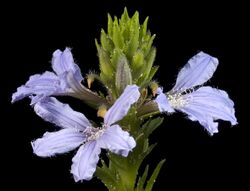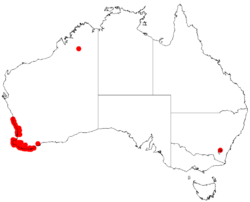Biology:Scaevola nitida
| Scaevola nitida | |
|---|---|

| |
| Scientific classification | |
| Kingdom: | Plantae |
| Clade: | Tracheophytes |
| Clade: | Angiosperms |
| Clade: | Eudicots |
| Clade: | Asterids |
| Order: | Asterales |
| Family: | Goodeniaceae |
| Genus: | Scaevola |
| Species: | S. nitida
|
| Binomial name | |
| Scaevola nitida | |

| |
| Occurrence data from AVH | |
| Synonyms[3] | |
|
Lobelia attenuata (R.Br.) Kuntze | |
Scaevola nitida (common name - shining fanflower) is an erect shrub in the family Goodeniaceae, native to Western Australia. It grows to a height of 0.3 to 3 m, and its blue-purple flowers may be seen from August to December.[4]
Description
Scaevola nitida is a spreading shrub growing up to 3 m tall, glabrous, and is sticky when young. The leaves have no stalk and are obovate to narrowly elliptic, and toothed, with the leaf blade itself being from 2 to 8.7 cm long by 7–40 mm wide. The flowers occur in terminal spikes which are up to 6.5 cm long. The sepals are rim-like and 0.3 mm high. The blue to lilac corolla is 13–20 mm long, pilose or glabrous outside, and bearded inside. The ovary is 2-locular. The grooved fruit is cylindrical and up to 4 mm long, and is smooth.[5]
Distribution and habitat
It is found in the IBRA Regions of the Esperance Plains, the Geraldton Sandplains, the Jarrah Forest region, the Swan Coastal Plain, and the Warren biogeographic region, growing on white or grey sand and clay, in coastal limestone cliffs and dunes.[4]
Taxonomy and etymology
It was first described and named by Robert Brown in 1810,[1][2] and its specific epithet, nitida, is a Latin adjective meaning "shining".[6]
References
- ↑ 1.0 1.1 "Scaevola nitida". Australian Plant Name Index (APNI), IBIS database. Centre for Plant Biodiversity Research, Australian Government. https://biodiversity.org.au/nsl/services/rest/name/apni/110804.
- ↑ 2.0 2.1 Brown, R. (1810). Prodromus florae Novae Hollandiae et insulae Van-Diemen, exhibens characteres plantarum quas annis 1802-1805. p. 584. https://www.biodiversitylibrary.org/page/2954740.
- ↑ "Scaevola nitida R.Br. | Plants of the World Online | Kew Science". http://powo.science.kew.org/taxon/urn:lsid:ipni.org:names:384270-1.
- ↑ 4.0 4.1 "Scaevola nitida". FloraBase. Western Australian Government Department of Parks and Wildlife. https://florabase.dpaw.wa.gov.au/browse/profile/7626.
- ↑ Carolin, R.C. (2020). "Scaevola nitida". Flora of Australia. Australian Biological Resources Study, Department of Agriculture, Water and the Environment, Canberra. https://profiles.ala.org.au/opus/foa/profile/Scaevola+nitida. Retrieved 2020-03-23.
- ↑ "nitidus,-a,-um". http://www.plantillustrations.org/epithet.php?id_epithet=368456%3C/div%3E%3Cdiv%20class=.
Wikidata ☰ Q17480632 entry
 |

